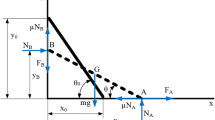Abstract
A classical mechanics approach of the falling ladder problem with and without friction is presented. The ladder falls freely under the influence of gravity. As the ladder slides on the floor, it is free to lose its contact with the wall. The general nonlinear differential equation of motion is derived and solved numerically using the Runge–Kutta method implemented by MATLAB. The variation of the contact force with the wall is calculated and used for detecting the angle of separation from the wall. The motion after separation has two degrees of freedom and it is also solved by the Runge–Kutta method. It is shown that the separation time from the wall and the reaction forces are higher than the corresponding no-friction values.




















Similar content being viewed by others
Data availability statement
The datasets generated during and/or analysed during the current study are not publicly available, but are available from the author on reasonable request.
References
Burke BA, Jackson Z, Kifowit SJ (2018) The falling ladder paradox revisited. Coll Math J 49(1):36–40
Ghorashi A, Ghorashi M (2020) Theoretical and computational analysis of the falling ladder problem. SN Comput Sci. https://doi.org/10.1007/s42979-019-0019-7
Glane S, Müller WH (2019) The sliding ladder problem revisited in phase space. Am J Phys 87(6):444–448
Kapranidis S, Koo R (2008) Variations of the sliding ladder problem. Coll Math J 39–5:374–379
Majumdar P, Roy S (2012) Friction controlled three stage ladder sliding motion in a non-conservative system: from pre-detachment to post-detachment. African Rev Phys 7(0009):67–81
Meriam JL, Kraige LG (2006) Engineering mechanics dynamics, 6th edn. John Wiley & Sons Inc, Hoboken, NJ, p 425
Oliveira JB, Carvalho PS, Mota MF, Quintas MJ (2015) Dynamics of a sliding ladder leaning against a wall. Phys Educ 50(3):329–334
Scholten P, Simoson A (1996) The falling ladder paradox. Coll Math J 27(1):49–54
Acknowledgements
The author appreciates the fruitful conversations he has had with Ali Ghorashi (his co-author in reference [2] and a physics Ph.D. candidate at M.I.T.); as well as the constructive comments made by an anonymous reviewer on an earlier draft of this paper.
Funding
The author declares that no funds, grants, or other support were received during the preparation of this manuscript.
Author information
Authors and Affiliations
Corresponding author
Ethics declarations
Conflicts of interest
The author has no relevant financial or non-financial interests to disclose.
Additional information
Publisher's Note
Springer Nature remains neutral with regard to jurisdictional claims in published maps and institutional affiliations.
Rights and permissions
About this article
Cite this article
Ghorashi, M. New insights on the falling ladder problem. Meccanica 57, 2281–2292 (2022). https://doi.org/10.1007/s11012-022-01552-2
Received:
Accepted:
Published:
Issue Date:
DOI: https://doi.org/10.1007/s11012-022-01552-2




